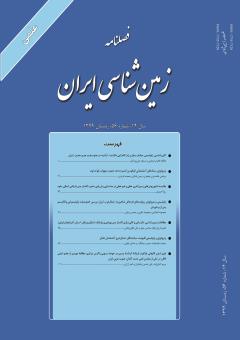مقایسه نتایج روش¬های زمین¬آماری خطی و غیرخطی در مدلسازی و ارزیابی ذخیره کانسار مس نارباغی شمالی ساوه
محورهای موضوعی :
1 - دانشگاه صنعتی اراک
کلید واژه: کانسار مس نارباغی شمالی ساوه, کریجینگ شاخص چندگانه, لاگ کریجینگ, Datamine, SGeMS ,
چکیده مقاله :
در پژوهش حاضر ارزیابی کانسار مس نارباغی شمالی ساوه با استفاده از روش های تخمین زمین آماری خطی و غیرخطی صورت گرفته و نتایج آنها با یکدیگر مقایسه شده است. برای این منظور ابتدا متوسط عیار و میزان ذخیره کانسار با روش های لاگ کریجینگ و کریجینگ شاخص چندگانه با استفاده از نرم افزار SGeMS2 برای عیار حدهای 1000، 1500، 2000 و 2500 گرم برتن (ppm) محاسبه شد و نمودارهای عیار- تناژ کانسار رسم شد. سپس به کمک نرم افزار Datamine مدلسازی کانسار صورت گرفت و متوسط عیار و میزان ذخیره کانسار با روش کریجینگ معمولی بلوکی نیز تخمین زده شد. نتایج پژوهش نشان میدهد که اختلاف ذخیره روشهای لاگ کریجینگ و کریجینگ معمولی بلوکی به ازای عیار حدهای مذکور به ترتیب برابر با 96/0، 18/19، 81/9 و 44/10 درصد است. همچنین اختلاف ذخیره بین روشهای کریجینگ شاخص و کریجینگ معمولی بلوکی نیز به ازای عیار حدهای مذکور به ترتیب برابر با 45/13، 21/9، 73/14 و 63/11 درصد است. بهطورکلی نزدیک بودن نتایج تخمین متوسط عیار و میزان ذخیره توسط سه روش مورد استفاده، دلیلی بر صحت نتایج و عملکرد پژوهش است. بالاتر بودن متوسط عیار در روش کریجینگ شاخص چندگانه نسبت به روش های دیگر، به دلیل اختلاط کمتر کانسنگ و باطله و درنتیجه درجه خلوص بیشتر بلوک های ماده معدنی در این روش است. همچنین علت بیشتر بودن میزان ذخیره با روش کریجینگ معمولی بلوکی به کمک نرم-افزار Datamine دخالت کاربر در تعیین منطقه تاثیر گمانه ها در فواصل عمقی کانی سازی شده در داخل گمانه هاست.
In this research, Saveh North-Narbaghi copper deposit was evaluated by using linear and nonlinear geostatistical methods and their results were compared. To achieve the goal, in the first step, average grade and ore reserve were calculated using log-kriging and indicator kriging with cut off grades of 1000, 1500, 2000, and 2500 (ppm) by SGeMS2. Then the deposit was simulated by Datamine software and the average grade and ore reserve were estimated through ordinary kriging method. The results of the research show that the differences between log-Kriging and ordinary Kriging with applied cut off grades for the ore reserve are 0.96%, 19.18%, 9.81% and 10.44% respectively. Also, the discrepancy between indicator Kriging and ordinary kriging methods with applied cut off grades are 13.45%, 9.29%, 14.73% and 11.63% respectively. In general, the accuracy of the results and research performance are understood from the proximity of the results of average grade and amount of ore reserve estimation employed by all three methods. However, the average grade with different cut off grades by multiple indicator Kriging method is higher than the other methods due to lower blending ore and gangue in this method and high degree of purity of ore blocks compared with the other methods. Also, the reason of overestimation obtained by ordinary block kriging using Datamine software is related to the user's intervention in determining the mineralized intervals in the boreholes on the basis of experience and recognition of the deposit condition.
احمدی، ر.، 1388. کاربرد الگوهای آماری در ارزیابی ذخایر معدنی با نگرشی بر معدن مس علی¬آباد یزد. گزارش طرح پژوهشی طرف قرارداد با دانشگاه علم و صنعت اراک، 102.
احمدي، ر.، 1398. درسنامه ديجيتال (الکترونيکي) ارزيابي ذخاير معدني. انتشارات دانشگاه صنعتی اراک، 250.
پیچاب کانسار، مهندسین مشاور، 1394. گزارش پایانی عملیات اکتشافی در محدوده اکتشافی مس نارباغی شمالی، 356.
جلالي، م.، رحیمی پور، غ.ل.، دیانتی، م.ر. و تقوایی نژاد، م.، 1388. بررسي اعتبار برآوردگرهاي کريجينگ خطي و غيرخطي در پهنهبندی بلوک¬هاي کانسنگ و باطله در معدن مس سرچشمه. کنفرانس ملی علوم زمین، سال بیستم، 79، 95-10.
حسنی پاک، ع.ا. و شرفالدین، م.، 1380. تحلیل دادههای اکتشافی، انتشارات دانشگاه تهران، 987.
حسنيپاك، ع.ا. و خالصی، م.ر.، 1382. مدیریت خطا و ریسک در اکتشاف، موسسه چاپ و انتشارات دانشگاه تهران، 382.
حسنی¬پاک، ع.ا.، 1377. زمین¬آمار (ژئواستاتیستیک)، انتشارات دانشگاه تهران، 314.
قاجار، ی. و سلطانی محمدی، س.، 1393. مقایسه روش¬های کریجینگ شاخص و لاگ کریجینگ در تفکیک کانسنگ¬های هماتیتی و مگنتیتی در معدن آهن جلال¬آباد، همایش ملی زمین¬شناسی و اکتشاف منابع، شیراز.
کایدانی، م. و دلبری، م.، 1389. پهنه¬بندی شوری خاک و ارزیابی ریسک شوری در منطقه میانکنگی (سیستان) با استفاده از روش¬های زمین¬آماری، مجله علمی کشاورزی، 35، 1، 60-49.
مدنی، ح.، 1374. مبانی زمین¬آمار. انتشارات دانشگاه صنعتی امیرکبیر- واحد تفرش، 659.
مدني، ح.، ۱۳۷۶. اصول پي¬جویي، اکتشاف و ارزيابي ذخاير معدني. انتشارات خانه فرهنگ، 816.
Alavi, M., 1991. Sedimentary and structural characteristics of the paleo-Tethys remnants in Northeastern Iran. Geological Society of America Bulletin, 103, 8, 983- 992.
Annels, A.E., 2012. Mineral Deposit Evaluation: A Practical Approach, Chapman and Hall, London, XV, 436.
Bohling, G., 2007. SGeMS Tutorial Notes in Hydrogeophysics: Theory, Methods, and Modeling. Boise State University, Boise, Idaho, 26.
Choudhury, S., 2015. Comparative Study on Linear and Non-Linear Geostatistical Estimation Methods: A Case Study on Iron Deposit, Procedia Earth and Planetary Science, 11, 131–139.
Gossage, B., 1998. The Application of Indicator Kriging in the Modeling of Geological Data, Proceedings of a one day symposium: Beyond ordinary kriging. October 30th, Perth Western Australia. Geostatistical Association of Australasia.
Journel, A.G., 1983. Nonparametric estimation of spatial distributions: Mathematical Geology, 15, 445–468.
Journel, A.G., 1989. Fundamentals of Geostatistics in Five Lessons, Short Course in Geology, American Geophysical Union, 8, 57.
Remy, N., Boucher, A. and Wu, J., 2006. SGeMS User’s Guide, Stanford University, Stanford, 129.
Remy, N., Boucher, A. and Wu, J., 2009. Applied Geostatistics with SGeMS: A User's Guide, Cambridge University Press, New York, 284.
Rendu, J.M., 1981. An Introduction to Geostatistical Methods of Mineral Evaluation, South African Institute of Mining and Metallurgy monograph series, Johannesburg, 84.
Stoecklin, J., 1968. Structural history and tectonics of Iran: A Review. American Association of Petroleum Geologists, 52, 7, 1229–1258.
Switzer, P., 1977. Estimation of spatial distributions from point sources with application to air pollution measurement: Bulletin of the International Statistical Institute., 47, 123–137.


